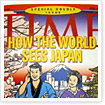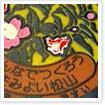|
VISUAL CULTURE IN
JAPAN: Summer session
at Temple University Japan, Minami Azabu (Tokyo)
VERNACULAR
VISUAL CULTURE IN JAPAN
THE LOGIC AND LOCATION
OF METAPICTURES IN DAILY PHOTOJOURNALISM
ELECTRONIC DEMOSTRATION
PORTFOLIOS for Visual
Anthropology Majors
FROM PURILURA (Print
Club) TO SHA-MAIL TO PURIMO-DOS AND BACK:The
Beat Goes On.
CELEBRATING LIFE AFTER
DEATH: The Appearance
of Snapshots in Japanese Pet Grave Sites.
EMPLOYEES MUST WASH
HANDS: A Photo Essay
(in process)
GHOST PHOTOGRAPHY:
Nihon No Shinrei Shashin as Home Media
LOOKING AT JAPANESE
SOCIETY: Hashiguchi
George as Visual Sociologist
|
|

|
 |
 |
VISUAL
CULTURE IN JAPAN
Summer session
at Temple University Japan,
Minami Azabu (Tokyo)
May 14-July 1, 2004
Temple
University offers several options for students
considering a summer program of study in Tokyo,
Japan. Japanese Visual Culture, is a six-week
program scheduled for May 14-June 27, 2004, which
focuses on the central theme of human visuality
and specifically visual culture in modern Japan.
Based at Temple's branch campus in Tokyo, Temple
University Japan, the program is designed for
upper-level undergraduate and graduate students
interested in Japan, Asian Studies, visual anthropology,
visual sociology, media studies, or inter-cultural
communication. Students enroll in two courses
carrying three credits each for a total of six
credits.
Temple
University has the largest and longest surviving
American University campus in Japan -- see http://www.tuj.ac.jp/newsite/main/index.html


|
|
 |
 |
VERNACULAR
VISUAL CULTURE IN
JAPAN
Dr. Richard
Chalfen (Temple University) was interviewed for
a local newspaper concerning his views on Japan
as a visual culture. The interview was conducted
by Kendra Sterns in East Harwich, Cape Cod, Massachusetts
during July, 2002. All photographs and links were
supplied by Dr. Chalfen after the interview.
 |
|
 |
 |
THE
LOGIC AND LOCATION OF METAPICTURES IN DAILY PHOTOJOURNALISM
A survey of
800+ newspaper photographs from The New York Times
(between 2002-2004) that in various ways are about
pictures, mostly photography. These images either
include pictures or are about picture-making, in
some ways, teaching readers/viewer about dimensions
of contemporary, comparative international visual
culture.
 |
|
|
|
|
|
 |
 |
CELEBRATING
LIFE AFTER DEATH:
The Appearance of Snapshots in Japanese Pet Grave
Sites.
Paper
in preparation for “Looking at Animals, Looking
at Society” -- Special Issue of Visual Studies
- Fall, 2004
Within a larger study of Japanese personal photography
in contexts of home media, home mode communication,
and Japanese culture, this paper offers a detailed
case study of how snapshots are used in a sample
of pet cemeteries in contemporary Tokyo, Japan.
Meanings of these images are discussed in terms
of animism, memory, communication, household maintenance,
pet-extended families and connections to patterns
of human ancestor worship.

|
|
 |
 |
EMPLOYEES
MUST WASH HANDS: A
Photo Essay
(in process)
This photo essay addresses
the ubiquitous bathroom sign: “Employees
Must Wash Hands Before…” What variations
are found? More to the point, why do we need to
see this sign? Why is either the sign or the prescribed
activity necessary? Are we witnessing a case of
mandated hygiene or the prolonged yet persistent
death of Common Sense?
|
|
|
|
 |
 |
ONE
HOUR PHOTO
A
Self-Interview
We are speaking with Dr. Richard Chalfen, Professor
of Visual Anthropology at Temple. He has been
a member of our faculty since 1972, specializing
in cross-cultural studies of pictorial home media.
The popularity of the recent feature film, One
Hour Photo (OHP) prompted us to contact Dr. Chalfen.

|
|
|
|
 |
| back
to top |

